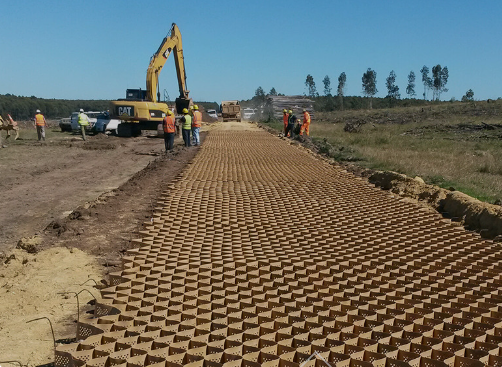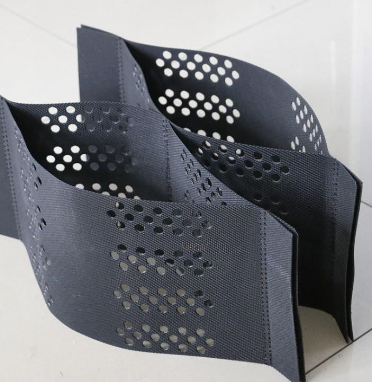- Understanding the Role of Geomembrane Liners in Waste Management
- Innovations in Geomembrane Liners for Water Management
- Geomembrane Liners: A Comprehensive Guide
- The Future of Geomembrane Liners in Civil Engineering
- Geomembrane Liners: Enhancing Landfill Stability
Manager:
WhatsApp:+86 177 0135 2670
Tel:+86 177 0135 2670
Email:marketing@okorder.com
Address:3rd Floor, No.2 Building, No.1 Sanlihe Road
What is the difference between a geocell and a geogrid?
In the realm of civil engineering and environmental protection, geosynthetics play a pivotal role in addressing various challenges, including slope protection. Among these geosynthetics, geocells and geogrids are commonly employed solutions. Both serve to reinforce soil structures, prevent erosion, and stabilize slopes. However, understanding the nuances between them is crucial for selecting the most suitable option for specific projects. In this article, we delve into the differences between geocells and geogrids, particularly in the context of slope protection.

Geocell Slope Protection: Enhancing Stability
Geocell slope protection involves the use of cellular confinement systems to bolster the stability of slopes and prevent soil erosion. These cellular structures consist of interconnected cells typically made from high-density polyethylene (HDPE) or other durable materials. When filled with soil or aggregate, they form a stable matrix that distributes loads and enhances soil confinement.
Understanding Geocells:
Geocells, also known as cellular confinement systems or cellular confinement geosynthetics, are three-dimensional honeycomb-like structures. They are manufactured from strips of high-strength, low-density polyethylene (HDPE) or other suitable materials. These strips are ultrasonically welded or heat-bonded to form the characteristic cellular configuration.
Advantages of Geocells:
Geocells offer several advantages for slope protection projects:
1. Enhanced Load Distribution: The cellular structure of geocells improves load distribution over a wider area, reducing pressure on the soil and minimizing the risk of slope failure.
2. Increased Vegetation Growth: Geocells provide a conducive environment for vegetation growth, promoting ecological restoration and enhancing the aesthetic appeal of the slope.
3. Flexibility: Geocells can conform to irregular terrain and accommodate settlement, making them versatile for various slope configurations.
4. Durability: Constructed from robust materials, geocells exhibit high resistance to environmental factors such as UV exposure, chemical degradation, and biological attack, ensuring long-term performance.
Applications of Geocells in Slope Protection:
Geocells find extensive application in slope protection projects, including:
- Steep slope stabilization
- Erosion control on embankments
- Vegetated retaining walls
- Landscaping and green infrastructure development
Geogrids: Reinforcing Slopes with Grid Structures
In contrast to geocells, geogrids are two-dimensional structures consisting of intersecting ribs or bars, typically made from polymer materials such as polyester, polyethylene, or polypropylene. These ribs form a grid-like configuration, which is either extruded or woven, depending on the manufacturing process.
Understanding Geogrids:
Geogrids are characterized by their open-grid design, which provides tensile reinforcement to soil structures. They are available in various configurations, including uniaxial and biaxial grids, each tailored to specific engineering requirements.
Advantages of Geogrids:
Geogrids offer distinct advantages for slope reinforcement:
1. High Tensile Strength: Geogrids exhibit high tensile strength, enabling them to withstand significant loads and distribute stresses effectively within the soil mass.
2. Improved Bearing Capacity: By confining soil particles, geogrids enhance the bearing capacity of weak soils, allowing for the construction of stable slopes even on marginal terrain.
3. Ease of Installation: Geogrids are lightweight and easy to handle, facilitating quick and efficient installation, thereby reducing labor and construction time.
4. Compatibility with Various Fill Materials: Geogrids can be used with a wide range of fill materials, including soil, aggregate, and recycled materials, providing flexibility in design and construction.
Applications of Geogrids in Slope Protection:
Geogrids are employed in various slope protection applications, including:
- Reinforced soil slopes
- Mechanically stabilized earth (MSE) walls
- Retaining walls
- Roadway embankments
- Landfill slope stabilization
Differentiating Between Geocells and Geogrids:
While both geocells and geogrids serve to reinforce slopes and prevent erosion, they differ in several key aspects:
1. Structural Configuration: Geocells consist of three-dimensional cellular structures, whereas geogrids are two-dimensional grids with intersecting ribs.
2. Load Distribution: Geocells distribute loads over a wider area, while geogrids provide tensile reinforcement within the soil mass.
3. Flexibility: Geocells are more flexible and conformable to irregular terrain, whereas geogrids offer high tensile strength and compatibility with various fill materials.
4. Installation: Geocells are typically filled with soil or aggregate onsite, while geogrids are placed within the soil mass during construction.
5. Applications: Geocells are well-suited for vegetated slopes and green infrastructure projects, while geogrids are commonly used in reinforced soil structures and mechanically stabilized earth walls.

Conclusion: Selecting the Right Solution for Slope Protection
In conclusion, both geocells and geogrids offer effective solutions for slope protection, each with its unique advantages and applications. When determining the most suitable option for a particular project, factors such as site conditions, design requirements, and budget considerations should be carefully evaluated. Whether opting for geocell slope protection or geogrid reinforcement, leveraging the benefits of geosynthetics can contribute to the durability, stability, and sustainability of slope structures, ensuring long-term performance and environmental resilience."






